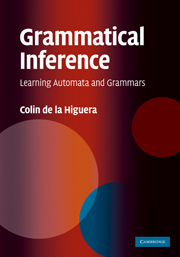Book contents
- Frontmatter
- Contents
- Preface
- Acknowledgements
- 1 Introduction
- 2 The data and some applications
- Part I The Tools
- Part II What Does Learning a Language Mean?
- 7 Identifying languages
- 8 Learning from text
- 9 Active learning
- 10 Learning distributions over strings
- Part III Learning Algorithms and Techniques
- References
- Index
8 - Learning from text
from Part II - What Does Learning a Language Mean?
Published online by Cambridge University Press: 05 July 2014
- Frontmatter
- Contents
- Preface
- Acknowledgements
- 1 Introduction
- 2 The data and some applications
- Part I The Tools
- Part II What Does Learning a Language Mean?
- 7 Identifying languages
- 8 Learning from text
- 9 Active learning
- 10 Learning distributions over strings
- Part III Learning Algorithms and Techniques
- References
- Index
Summary
No quería componer otro Quijote -lo cual es fácil- sino el Quijote. Inútil agregar que no encaró nunca una transcriptión mecánica del original; no se proponía copiarlo. Su admirable ambición era producir unas páginas que coincidieran palabra por palabra y línea por línea con las de Miguel de Cervantes. Mi empresa no es difícil, esencialmente leo en otro lugar de la carta. Me bastaría ser inmortal para llevarla a cabo.
Jorge Luis Borges, Pierre Menard: autor del Quijote, Ficciones © 1995. Maria Kodama. All rights reserved.Apart from the fascinating (and phoney) linguistic challenge (could a computer, like the young Tarzan of the Apes, learn a language by simply reading books written in it?), it has an interesting position in syntactic pattern recognition.
Laurent Miclet (on grammatical inference) on (Miclet, 1990)Learning from text consists of inferring from a presentation of examples that all come from the target language. The learner is asked to somehow generalise from the data it sees while not having counter-examples that would help it refrain from over-generalising.
Identification in the limit from text
Learning from text is considered by many to be the essence of language learning. It is in a sense the initial problem, the one with least constraints, and the one that, once we show it cannot be solved, allows us to consider making the problem easier by adding some helpful information like negative examples, knowledge about the structure or the possibility to interrogate an Oracle.
- Type
- Chapter
- Information
- Grammatical InferenceLearning Automata and Grammars, pp. 173 - 183Publisher: Cambridge University PressPrint publication year: 2010

